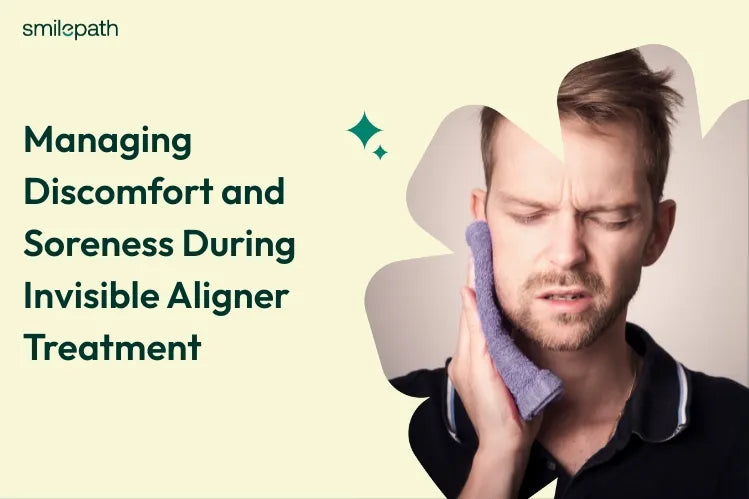
Table of contents
What are Invisible Aligners?
Invisible aligners are a series of clear, custom-made trays that fit snugly over your teeth. Their purpose is to slowly move your teeth into the desired alignment, ultimately leading to a more straightened and improved smile. Treatment plans typically involve wearing a new set of aligners every one to two weeks, with each set applying slight pressure to move your teeth.
Factors Leading to Discomfort
It's important to remember that discomfort during invisible aligner treatment is normal and is often a sign that the aligners are working as intended. The pain primarily occurs for two main reasons:
Pressure on Teeth
The aligners are designed to exert gentle but consistent pressure on your teeth to move them into the desired position. This pressure can cause the teeth to shift, leading to some discomfort, especially during the initial days of wearing a new set of aligners.Soft Tissue Irritation
At Smilepath , our invisible aligners are meticulously crafted to match the contours of your gums perfectly. However, when using aligners from other providers, you may encounter a potential issue – the edges of these aligners can create friction against your lips, cheeks, or tongue, resulting in discomfort and the formation of sore spots in your mouth.
Ways to Alleviate Discomfort
Now that we've covered why discomfort occurs, let's explore some strategies to manage it effectively:
Over-the-Counter Pain Relief
Over-the-counter pain relievers such as ibuprofen or acetaminophen can help alleviate the discomfort associated with invisible aligners. However, always consult your orthodontist or dentist before using any medication, especially if you have allergies or medical conditions that could interact with these drugs.
Cold Compresses
If you experience significant soreness or swelling, you can apply a cold compress to the affected area for 15-20 minutes at a time. This may assist in diminishing inflammation and offering momentary comfort.
Orthodontic Wax
Orthodontic wax is a handy tool for preventing irritation caused by the edges of your aligners. Apply a small amount of wax to any rough or sharp edges, creating a protective barrier between the aligner and your soft tissues.
Maintain Proper Oral Hygiene
Maintaining excellent dental care is essential while undergoing treatment with clear aligners. Keeping your teeth and aligners clean can prevent additional discomfort caused by issues like cavities or gum irritation. Brush and floss your teeth regularly, and clean your aligners according to your orthodontist's recommendations.
Use Chewies
Chewies are soft, cylindrical cushions made of a silicone-like material. By biting down on them for a few minutes each day, you can help seat your aligners properly and reduce discomfort.
Gradual Adaptation
Your mouth will gradually adapt to the aligners over time. While you may experience discomfort with each new set of aligners, it usually diminishes after a few days as your teeth adjust to the pressure.
Stay Hydrated
Drinking plenty of water can help with dry mouth and minimize irritation caused by the aligners. Staying hydrated is a good practice, but it can be especially beneficial during your treatment.
Maintain a Soft Diet
During the first few days of wearing a new set of aligners, it's a good idea to stick to a soft diet to minimize chewing-related discomfort. Choose options such as soups, mashed potatoes, yogurt, and blended drinks.
Conclusion
Remember that this discomfort is temporary and often a sign that your treatment is progressing as intended. By following these practical tips, you can manage the discomfort effectively and work towards the smile you've always wanted. So, stay patient, stay consistent, and soon you'll be showing off your beautifully aligned teeth with confidence.
FAQs
Discomfort typically peaks within the first few days of wearing a new set of aligners and gradually subsides as your teeth adjust to the pressure. Most people experience relief within a week.
If you're experiencing discomfort persistently, or if sore spots continue to develop, it's crucial to communicate with your provider or orthodontist. They can provide guidance, make necessary adjustments, or address any concerns to ensure your treatment remains comfortable and effective.


 Australia
Australia New Zealand
New Zealand Malaysia
Malaysia English
English Portuguese
Portuguese English
English English
English English
English English
English English
English Canada
Canada